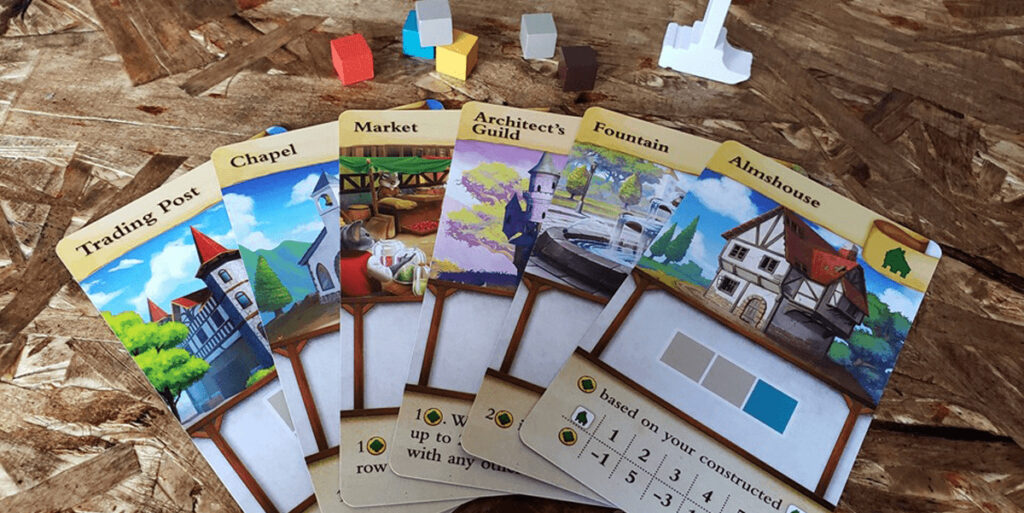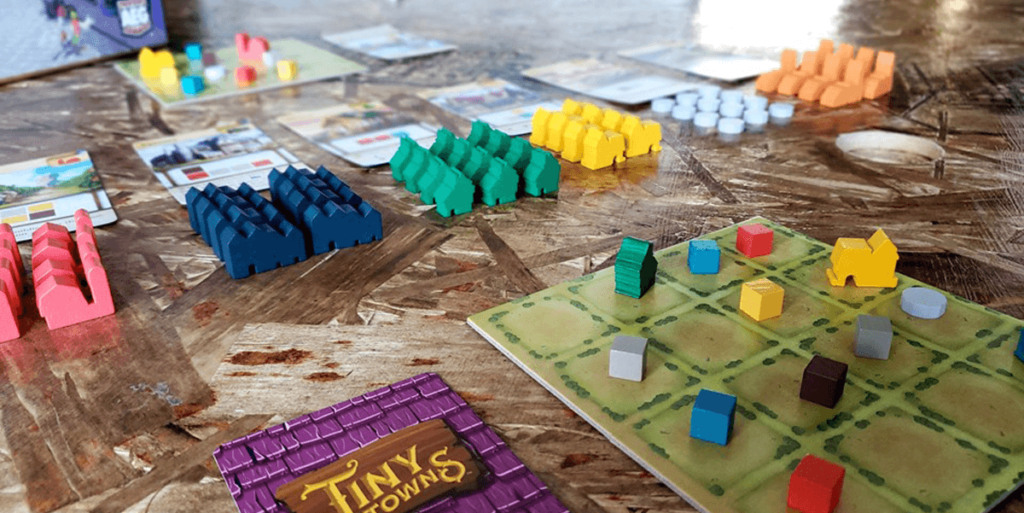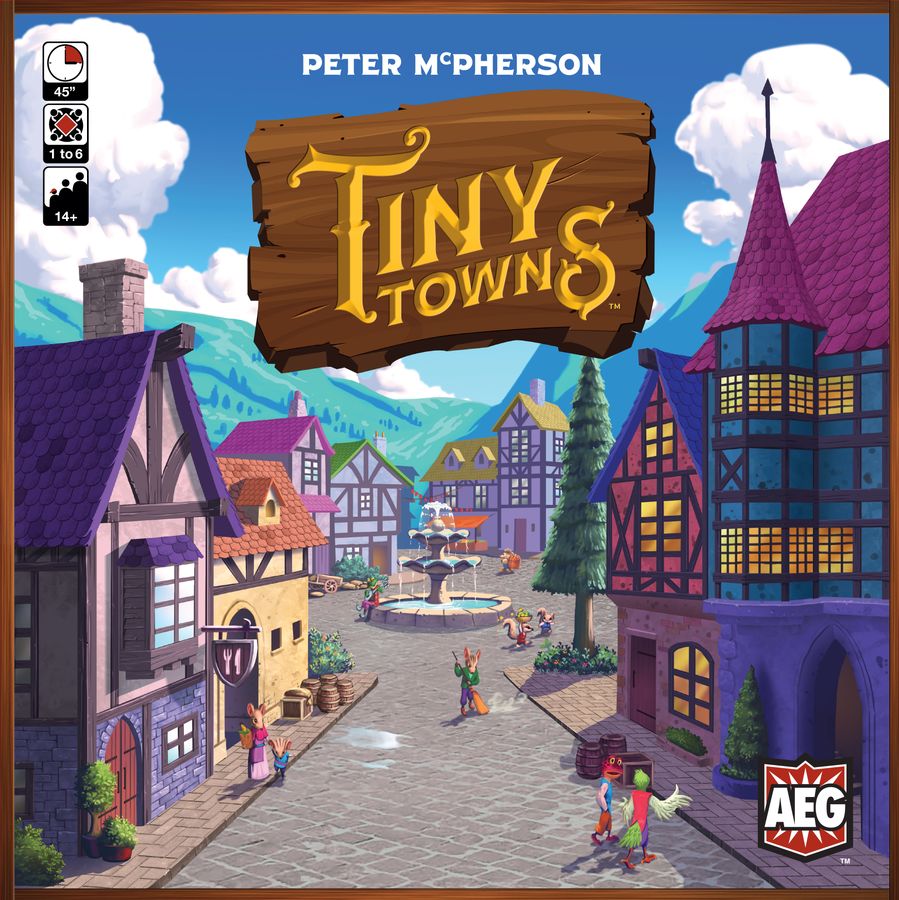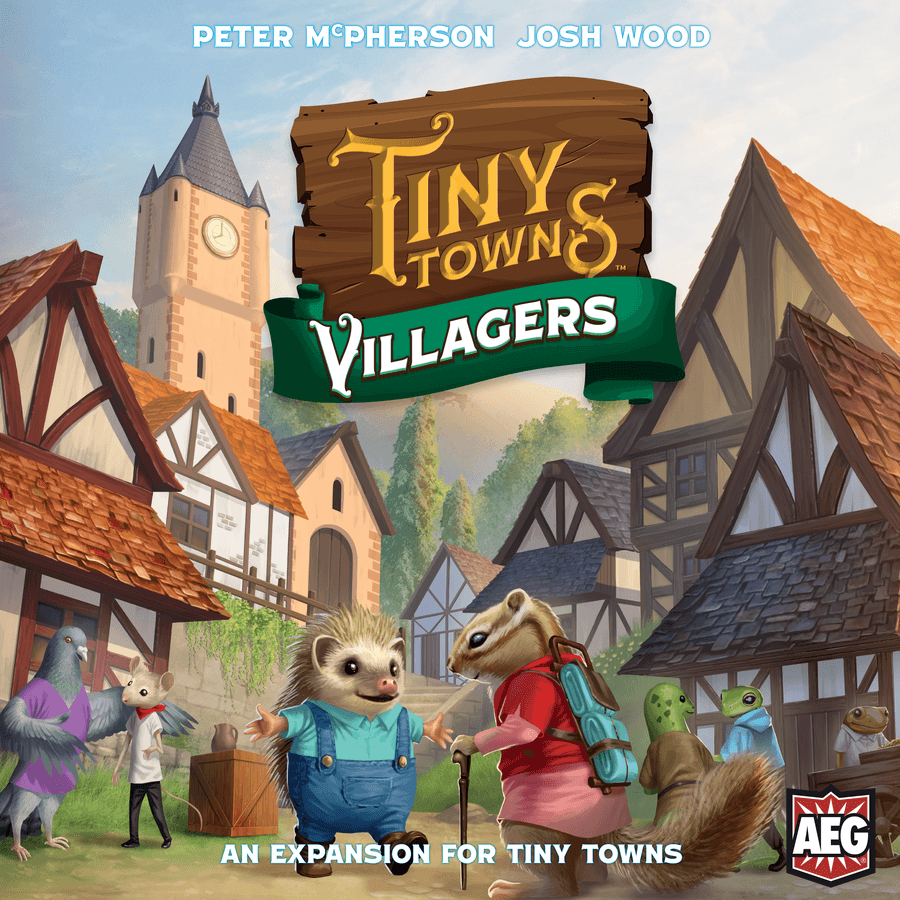If you’re here for the Villagers expansion review, you can just jump there. Otherwise read on for both reviews.
Tiny Towns Review
Tiny Towns is a damning indictment on urban sprawl, overcrowding, and an ever-expanding society’s need for quick, affordable housing! Actually, it’s not. It’s a really cute abstract puzzle about space optimisation, forward planning, and the most adorable little wooden buildings. These days you need a controversial strapline to pull people in though, so with that out of the way, let’s take a look at AEG and Peter McPherson’s 2019 puzzler.
Who lives on your block?
Tiny Towns revolves around the use of wooden blocks. Loads and loads of little wooden cubes of various colours. In the middle of the table there are some cards showing you the buildings you can construct during the game. Farms, cottages, theatres, inns – that sort of thing. Each building is made of a few cubes placed in the correct places on your 4×4 player board. It might be as simple as a well, which is a brown and a grey cube next to one another (wood and stone, respectively), or something more complicated, like a bakery. A bakery is two red blocks, with a blue block between, and a yellow block next to that, like a Tetris T-piece.
Nice and easy so far. Get some blocks, make nice patterns on the board. Here’s where things get interesting though. The shapes for each building can be rotated and flipped to your heart’s content, as long as the blocks’ relative positions to one another is correct. When you finish a shape, during your turn you can remove the cubes that have gone towards it and take one of the cute wooden buildings that represent it, and place it in any of the spaces the cubes were. So now that thing that was taking up four of your precious 16 squares only takes up one, and you can start working towards something else.
Merge in turn
If the idea of the game so far sounds familiar, but you’re not sure why, there’s a good chance you own a smartphone. If you’re not already playing one, there’s a good chance you’ve seen a thousand adverts for the recent craze of ‘merge games’. Drag three things together and pow!, you’ve got a new, slightly better thing. Repeat ad-nauseum. This idea is pretty close to the core concept for Tiny Towns, except there’s only ever one generation of merging.

At first, it seems like a pretty easy game. There’s plenty of space, and tons of options. Each of the building cards clearly shows how it’ll score at the end of the game, with relation to any of the other buildings on offer. For example, a cottage on its own scores nothing, but a farm on your board means that up to four cottages will score three points each. This is where things start to get tricky, however. For a start, you don’t always get to choose which resource cube you have to place next. Each player takes a turn naming a resource/colour, and all players have to place that same cube on their boards. Pretty annoying when you’re desperate for a wood cube but some joker keeps choosing stone. Better make sure you’ve got somewhere on your board it can still be useful, despite your best plans.
Then there’s the issue of space. At first it’s not an problem, but as the game progresses, each building permanently blocks a space. Not only do you have fewer squares available to place blocks, you also start blocking some possible shapes, because there just isn’t room for them. Very quickly you realise Tiny Towns is a game about optimisation. Optimisation of your space, and optimisation of your scoring opportunities.
Fun house
I’ve made the game seem very mechanical so far, so it’s time to tell you that Tiny Towns is fun, and to tell you why. Plotting what’s going to go where is so satisfying when it works out, and you end up with this miniature metropolis that banks you big points. But the real fun comes with the other players around the table. The cursing, the exasperated groans, and the “I cannot believe you chose brick!” cries of anguish. Your plans will almost never work out exactly the way you want it to, because some other git around the table is trying to do something else. Your player boards are visible to everyone, so it’s obvious to everyone (especially when someone takes it upon themselves to tell the table) when one player’s got a healthy lead.

I’ve played a four-player game where I was absolutely desperate for a brick to finish a high-scoring building near the end of the game, but the other players chose to pick anything except brick, just to force me to fill my board, thus ending my game. It doesn’t have to be played this way, with so much passive interaction, but if you’ve got a family or regular group playing, it can definitely happen. Far from being anger-inducing, it was really funny, because Tiny Towns isn’t a heavy, serious game. It’s a light, charming, quick game.
The biggest drawback Tiny Towns has is the one I just mentioned. When a player runs out of places to put blocks, it’s game over. Final scoring doesn’t happen until everyone has finished, and if you’re playing with newbies, it can mean they’ve got a little wait while the rest of the players construct their wooden wonders. It’s not a massive problem, unless you’re playing with lots of players. Out of the box it supports one to six players, but with enough cubes, printed player mats, or even pencils and paper, you could scale this game up to play with 50+ people.
Final thoughts
Tiny towns is a fantastic abstract puzzler. There are tons of different building types with different scoring conditions, which keep the game fresh and interesting. I love that it can play with pretty much any player count, if you don’t mind getting creative with making your own boards, or drawing on paper. There’s a solo mode included, where a deck of cards decide which colour cube you get next, which is a fun challenge and good practice for the main game.
If you don’t enjoy spatial puzzles, it’s probably not going to do much for you. Some people don’t enjoy them, and some people just don’t have a brain that works in that way, but then, not every game is going to appeal to everyone. A game usually takes comfortably under an hour, but scale that up for every extra player you have in the game.
If you like games like The Isle of Cats, Bärenpark, Patchwork, or even the aging Blokus, I think you’ll love Tiny Towns. It’s an interesting twist on the polyomino tile-placement genre, less than £35, and readily available. Plus, if you do find yourself getting tired with it, there are expansions to breathe new life into the game. For example, Tiny Towns: Villagers, which you can read about below.
Review copy kindly provided by Alderac Entertainment Group. Thoughts and opinions are my own.
Tiny Towns: Villagers Review
There are a couple of expansions available for Tiny Towns, both coming out the year after the main game, in 2020. I was sent a copy of Tiny Towns: Villagers to review, and I’ll be honest, I wasn’t really sure what they could do with the formula so didn’t go into it with high hopes. I was pleasantly surprised.
As the title implies, the biggest new additions are the villagers. They’re a collection of cute animal meeples in the shapes of mice, squirrels, birds, and other little forest folk. Three of them get plonked into three corners of your board at the start of the game, and you’re given a second, teeny board to put in front of you too – a lodge. The lodge is just a holding board really, where villagers go when they’re removed from the board, but it also has a nice reminder of how buildings for villagers are formed.
Mousey housey
If you complete a building by placing the last block on the same space as a villager, they’re then actively working in whatever building it happens to be. At the start of the game, a couple of different villager abilities are chosen at random. When you have enough activated workers, you can choose to use these abilities, which vary from letting you build with fewer resources than you need, to replacing an entire building with a different kind.

If you’ve played the Tiny Towns base game, you’ll know that there’s already a lot to consider when you’re choosing what to build where, so you’ll understand the added layer of complexity the villagers add. For someone like me, that’s great. I love a game with a bit more meat on its bones, and Villagers is certainly meaty. It’s not even as simple as just making sure the buildings finish in a creature’s space, as you can purposely shunt them around the board until they’re in positions more in line with your plans.
In addition to the new meeples, there are also a decent number of new building cards thrown in too. You can happily play the base game and just add in the new buildings if you want to.
Final thoughts
When you look at what’s in the box, the ~£25 you’ll pay for Tiny Towns: Villagers can look a bit steep. It’s a handful of cards, six small boards, and 20 animal meeples. If your interest with Tiny Towns is “It’s okay, but I’m not crazy about it”, then I’d wait to catch it in a sale. If you love Tiny Towns however, Villagers is essential in my opinion. Especially if you love a bit more weight in your games. The added layer of strategy it throws in, with very little overhead, is very satisfying.
I wouldn’t recommend throwing anyone into their first or second game of Tiny Towns with Villagers included. There’s enough to get your head around already for those first few plays. The other place you might find a bit of hesitance is where you’ve successfully converted non-gaming parents, siblings, or friends to the original game. It might be a bridge too far if they’ve just about got to grips with the game.
For the rest of us though, if you don’t mind paying the £25, Villagers is a great expansion, adding a welcome layer of depth to an already-polished puzzle. Fans of Tiny Towns will really get a kick out of it, and let’s be honest – who doesn’t like playing with wooden squirrels?
Review copy kindly provided by Alderac Entertainment Group. Thoughts and opinions are my own.
Tiny Towns is available from our sponsor – Kienda. Sign-up using this link to get 5% off your first order over £60.

Tiny Towns (2019)
Designer: Peter McPherson
Publisher: Alderac Entertainment Group
Art: Gong Studios
Players: 1-6
Playing time: 45-60 mins

Tiny Towns: Villagers (2020)
Designers: Peter McPherson, Josh Wood
Publisher: Alderac Entertainment Group
Art: Gong Studios
Players: 1-6
Playing time: 45-60 mins
